One of the most challenging and exciting parts of the year is living without a long-term plan and being on your toes at any moment to seize a dive adventure as it flies by! Last Tuesday night around 11:30pm I learned a NOAA research cruise was short several divers for ten day monitoring cruise in the Dry Tortugas National Park. They invited me to join with only a couple of small hitches A) needing to have all paperwork approved and guest diving privileges invoked by personal decision of the NOAA Dive Safety Board, and B) being in Key West and on board for departure in ~18 hours.
Thanks to the incredible effort of NOAA Line Office Diving Officer Andy David and Diving Safety Officer Jack Javech, I received the world’s fastest diver approval possibly ever put through the US government! With no time to waste sitting by the computer in Key Largo, I was already on the road and almost to the ship when the green light email reached my phone. Thank you to the DSB voting members across the nation whose decision allowed us to blaze through red tape and made this experience possible! Thank you too Ray Boland, my UDS in Hawaii, for the amazing dive training which originally qualified me to dive for NOAA!
The science mission of the cruise was to monitor fish populations throughout the Dry Tortugas National Park, north and south Ecological Reserve and reef bank. This is a long-running project measuring the success of marine protected areas in the greater Florida Keys region. PBS even filmed a movie about the project, check it out here.
If the term MPA is new to you, I can help break it down.
By establishing no-take areas (where fish are safe from fishing and habitat is safe from trawling or drilling) entire ecosystems flourish. Science shows fish parents reproduce better (more eggs/sperm, bigger healthier juveniles, more potential mates etc) when they are physically bigger. Also many fish only begin to reproduce when they reach a certain minimum size. In order to have healthy fish stocks, you need places where big fish can live safely. Marine protected areas are also a great conservation tool because they protect small prey fish, coral, sponge, algae and invertebrates which all play a role in a healthy ocean. Reserves even end up benefiting fishing via the ‘spillover effect’. Because many fish are territorial, as populations grow and reserves fill up big fish literally spill over the boundaries of protected places. Although this science has been proven all over the world there is still resistance to establishing no-take reserves. It was exciting for me to be part of project that can show ocean-users in Florida great success within their own waters. Data from this project has shown more than half of all the spawning (reproducing) adult red grouper for the whole region live on the reefs of the Dry Tortugas park and reserves! To learn more about MPAs watch my ocean icon Dr. Sylvia Earle’s TEDtalk about building ocean Hope Spots here!
The trip was made up of 21 diver/scientists of all variety, from Coral Reef Ecosystem Division (I used to work for them in Hawaii), University of Miami, Nova Southeastern, Florida State University, National Park Service, Florida Fish & Wildlife Conservation Commission, and of course NOAA. This hugely diverse group came together for a fish counting extravaganza! We lived and worked on the M/V Spree, a 100 foot live-aboard charter decked out in dive comforts. The beanbags on the sundeck were my favorite spot to warm up between dives! The crew ensured we slept soundly and ate incredibly well: coffee service, breakfast, morning snack, lunch always with soup, lunch dessert, afternoon snack, hearty dinner, dinner dessert, late night snack, and a chocolate basket sneakily placed so you walk past it about 20 times a day. The ship is owned and operated by wonderful hosts Frank and Melanie Wasson. Frank is a fellow ocean-lover from Idaho. (Proof we do exist! And yes, we do all run away to the ocean!)
The group was divided into five teams of four divers, two buddy pairs. At randomized sites throughout the park, teams leap into the water loaded down with flags, cameras, data sheets and measuring sticks. The team separates into pairs and swims to their own region of the habitat. There a flag is anchored and each diver separates from their buddy swimming 7.5 meters from the flag. Each diver is now at the center of their own 15m diameter cylinder and every fish that swims through the cylinder gets counted. Slowly rotating you also size every fish orbiting around you during the timed count. You’re allowed to swim around and look for small or sneaky fish that may be hiding under ledges or among coral fans. Everything large or small is accounted; you have to keep your eyes open for the coolest things which often only show themselves for a moment. Data is also collected on endangered coral, invasive lionfish and habitat characteristics. It’s a lot to get done in a hurry!
Teams dive all day long leapfrogging one after another with each team diving four or five times in a workday. Two teams are in the water at once and the complex ballet of cat wrangling is managed by Deck Supervisor Melanie who somehow manages to keep us all diving safely and on schedule. She and the deck crew were constantly in motion recording dive stats, double checking Nitrox mixes and refilling tanks immediately after a diver got back on deck. The rotation went something like this: drop team #1, prep team # 3, drop team #2, pick up team #1, prep team #4, drop team #3, pick up team # 2, prep team #5, drop team #4, pick up team #3, prep team #1, drop team #5, pick up team #4, prep team #2, drop team #1, and so on. Do I have you confused yet?
This process is extra exciting because we’re live-boating from a 100 foot live-aboard! After you surface the boat drives right at your bobbing head. When nearly on you the Spree falls off to starboard, propellers fly into reverse swinging the portside stern close to the group. As soon as the engines go neutral a big metal ladder is pushed off the swim step and a long line is tossed to someone in the water. As you drift by there’s a mere seconds-wide gap to pass up flags and cameras. Then divers swim like mad for the line, grab on and hold on to be towed behind the coasting ship. There you remove your fins, pull hand over hand to the ladder and climb up. It’s perfectly safe but can get quite ‘sporty’, as our deckhand liked to say, as the wind and swell picked up. Facing the hull of a charging 100-foot ship makes you VERY quickly appreciate the confident skill of your Captain.
All the science summary results won’t be done until the winter but we sure did count a lot of fish! The leapfrog method made this one of the most efficient operations I have ever been a part of. The team completed 794 dives for a combined 17.75 days underwater! I’ve counted fish on many projects before, but the last time I counted in the Atlantic was 2008 in the Bahamas. To say I started the trip pretty rock on my fish ID would be an understatement! Quickly I learned ‘fish that looks kinda like Hawaiian milletseed butterfly but with a slanty face bar’ (day 1 data sheet) was actually a spotfin butterflyfish. I was the cruise free agent and dove on team #1(Team 2:30 Naptime) and #2 (as the blonde in ‘Rob’s Angels’) before settling in on team #3(Team Old Reliable). Everyone was exceedingly helpful sharing their knowledge of the local species and giving me tricks and mnemonics for the tough ones. Special thanks go to my dive buddies Lisa McManus (#2) and Jeremiah Blondeau (#3) for telling me those mutton snappers were in fact not lane snappers and no matter what color it looked like, ‘Yes, that was a red grouper that swam up and stared at you’! The biggest compliment came the last day when PI/ Team Lead Dr. Steve Smith surfaced to tell me “You’ve now become a [fish counting] Jedi!”
We dove on every kind of habitat from sand and hard bottom low relief reef to pinnacles and layering coral mounds. My favorite dive came halfway through the trip. I jumped off the spree and immediately 80 feet below could see two huge goliath grouper by the side of a 30 foot tall coral pinnacle! I was a kid in a candy shop; I’m sure you could hear me giggling in my regulator. In a huge strike of counting karma (as if these 1.4m and 1.6m fish were not enough) the same dive I counted 75 beautiful blue parrotfish and a swirling tornado of chubs! Over the cruise I had the chance to count commercially important fish like black grouper, yellowmouth grouper, barracuda, snappers, jacks, and hogfish. Special sighting stuck out like the wild patches of endangered staghorn coral, along with a lemon shark, a bull shark, a long-nose seahorse, and a Southern stingray at least 2 meters wide!
This trip was chock full of gorgeous diving and it fell right into my experience conducting marine field research. It was a totally new experience counting new fish on a coral reef mostly composed of sponge and octocoral. I loved living on board with the crew of genuine, passionate, fun scientists. After data was entered every evening, I spent sunsets picking their brains about the state of coral reefs in Florida and beyond. It’s inspiring to hear from their experience and enlivening to discuss the needs for science communication and outreach to move conservation forward.
Future scholars (or Yolly or Oscar) have already been invited back to the M/V Spree for science or liveaboard adventures! I hope they will make it, as this was a wonderful experience for me! Special thanks to Diving Safety Officer Jack Javech, Primary Investigators and Science Directors Dr. Benjamin Ruttenberg and Dr. Steve Smith, Captain Frank and Melanie Wasson and their exceptional crew. During the cruise I had the chance to dive with talented scientist/photographer Kirk Kilfoyle. More of his work is available here.
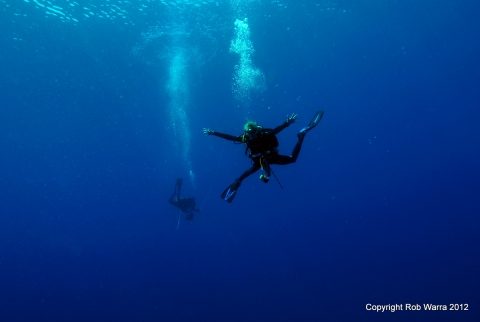

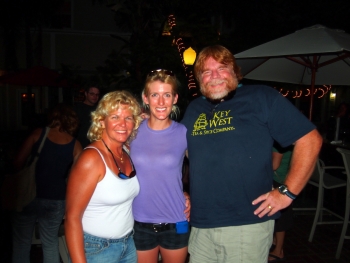
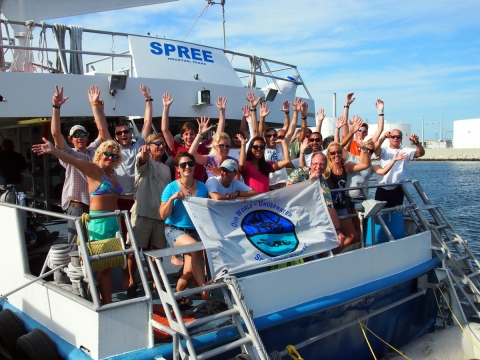
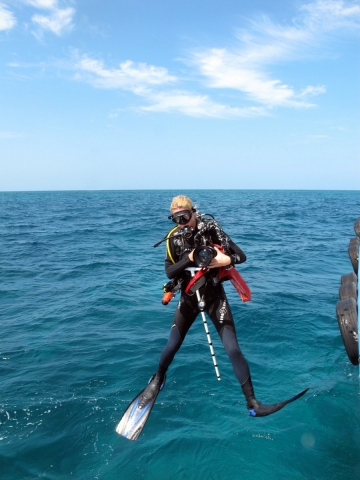





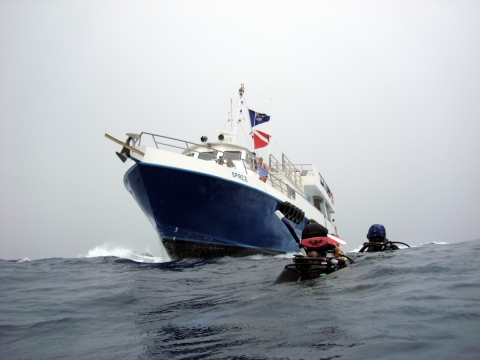



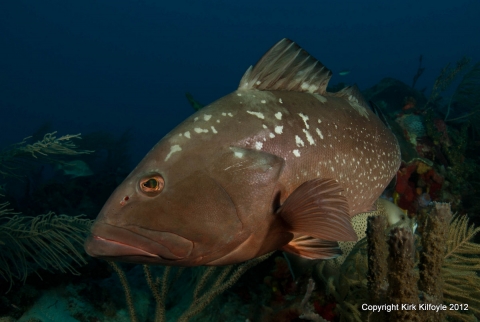









Great minds think alike right?! RE our post titles 😀